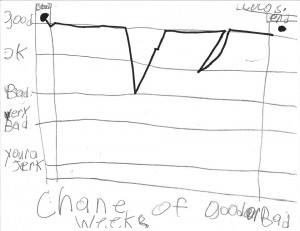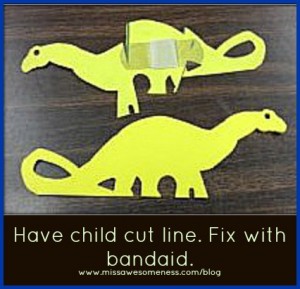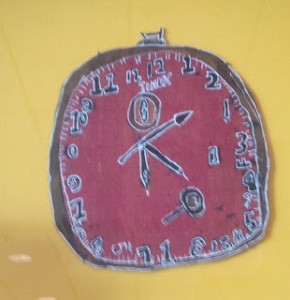Occupational Therapy
Hire This 4th Grader to Help You Fire Your Mother
Background: John is very angry with his mom about a big decision that was upsetting to him.
Mother reports: “John asked me into his room, shut the door, sat me down at his Lego table and told me he had to “let me go”. He handed me an envelope with some peppermints and bandaids. Compensation, I believe. This week he gave me and Shane (ed note: father) some progress charts. He said we could skip the meetings.”
Notice the chart that shows levels of behavior:
OT Lego Strategies for Children
Dear OT,
My preschooler, John, loves playing with Legos. Unfortunately he gets frustrated because his hands are weak and his fine motor skills aren’t as good as his classmates. Any ideas? – Jane
Hi Jane,
Legos are great for working on many developmentally appropriate skills. Some strategies you can teach your child to make Lego play a little easier include:
LEGO STRATEGIES (Click link to download as PDF) Lego strategies
(Note: Consider practicing on larger Legos first!)
PLACE LEGOS LOWER AND CLOSER TO BODY
Place the legos closer to his body and make sure they are lower than his arms. He can stand up and push down on the Legos for more strength (thanks to the physics of levers – this is true for staplers and similar items as well). That way his entire body is being used for the interlocking of the bricks, compensating for his hand weakness.
USE PALM, NOT FINGERS, TO FULLY INTERLOCK
For the bigger pieces, if interlocking bricks are in correct position, just not fully pushed together, first move the item closer and lower as noted above, then use the flattened palm of hand to press them down firmly. The palm has more force/easier than the fingers. If a tower, it may need to be stabilized with the other hand to prevent tipping over.
TEMPORARILY MOVE UNSTABLE AREAS TO A STABLE AREA TO ADD ON MORE PIECES
If there is empty space beneath part of a Lego due to the design, it can get difficult/frustrating to add onto that Lego area. Temporarily remove that part of the design so that it’s fully on the flat/stable surface. Add on the necessary extra pieces. Then place the entire part back where it belongs.
Jane, I hope this helps. I imagine there are many sites on the Internet that can be explored to find even more ideas. Good luck with John! Therapeutically yours, OT 🙂
PS: There are plenty of OT skills that can be worked on using Legos! Fine motor, visual motor, problem-solving, social skills…let me know if you want more information!
Kids are Awesome: Self-Advocacy Gone Awry
One of my power words of the year is SELF-ADVOCACY. Teaching children to ask for what they want and need to make their lives easier. Of course, when dealing with the awesomeness of children, it doesn’t always quite work as we expect. 🙂 One of my Facebook friends posted this about her child and I laughed hysterically. I screen-shot the status.
So my middle was annoying me and I kissed the top of his head, admittedly to encourage him to be on his merry way and stop blocking my Facebook, but instead he told me he needed another kiss. So I gladly kissed his curly head again and off he went. So I called after him, “I like it when you tell me what you needddddd…” To which he smiled and replied, “I need a rocket launcher and a car and a bazooka and machine gun and a rope…” That wasn’t what I meant.
OTs Help Put the Able into Actionable: R A W = S A
READY +ABLE +WILLING = Successful Action
A psychologist friend recently told me about the phrase “Ready, Willing, and Able”. All three components must be there for any Successful Action to occur.
R.A.W. = S.A.
Possible reasons for inaction:
*Ready, able, NOT willing
*Willing, able, NOT ready
*Ready, willing, NOT able
When the person is ready and willing yet not ABLE it is typically the most self-devastating. In all of the above cases, especially “not able”, an occupational therapist can help.
Whether it’s a challenge physically, mentally, or a combination of the two, OTs break down the issues and help figure out how to find and repair the missing link. Then all three components (ready, able, willing) are there, subsequently leading to an action, and therefore meaningful and appropriate participation!
If you click on the “Printables” tag, this should be up there as a PDF that can be easily printed. The first page is somewhat of a “cheat sheet” and pages 2-4 are the longer detailed version. Page 5 is an accident. Sorry. (Oh look, I managed to insert it here which is good because I also apparently don’t know to upload it to printables yet. Can you tell my website/type of blogsite is new and I have no idea what I’m doing?)
RAWSA in OT: Focusing on Successful Action
Click the read more link to see example stories of depression/executive functioning deficits affecting a person’s actions [and my typical excessive details]! (It turns out I also don’t know how to use the read more link appropriately either. AHAHAHAHAA. Soon!!)
Cutting/fine motor manipulation/imagination: OT Activity
ACTIVITY
1. Take dinosaur post-it or other random animal paper. Child cuts across animal.
2. Child is veterinarian and fixes animal. (Skim over the fact we were directly responsible for its hurt, cough).
3. Give child a band-aid.
4. Child puts animal pieces together in right orientation, secures band-aid.
See below about grading the activity, skills worked on, and extra notes, while I figure out how to add in a “read more” link 🙂
TO GRADE ACTIVITY (change difficulty level) depending on child’s strengths/weaknesses:
Cutting:
Harder: Multiple lines, thinner lines, curvy or wiggled lines, lower contrast lines, more directions, having child make own lines first and cut out own.
Easier: One thick line, high contrast, fewer directions, no line at all, thicker paper (like a manila folder, construction paper, index card), modified scissors
Band-aid:
Harder:Child gets out band-aid and performs rest of task independently or with minimal assistance, no prompting for sequencing
Easier: Open the band-aid or help the process (start it until manageable by child, such as peeling the bandaid pieces a tiny bit apart and child takes over). Help hold the papers down so child can apply bandaid.
Imagination:
Harder: Do not give the child a sample, fewer prompts, encourage playing pretend
Easier: Role model playing pretend yourself only, give child sample
SKILLS worked on with animal band-aid activity:
- Cutting
- Fine motor manipulation (opening and placing bandaid)
- Visuospatial organization (placing pieces back together)
- Imagination/creativity/flexibility (understanding concept via drama/pretend/silliness)
- Life skill (manipulating band-aid)
- Cognition/Problem-solving (figuring out how to use the band-aid and put it all together)
Notes:
1. Be silly/dramatic. Children with mental rigidity can handle this sort of task as it’s concrete enough to make sense, but the imaginative creative piece is helped by silliness. “Oh nooooo our poor dinosaur!! I hope we can fix him!!!”
2. KIDS LOVE BANDAIDS. I didn’t have any cool ones, but that would help even more. If you have more than one type, let them choose. Even children resistant to cutting/directions may complete this task if they see a band-aid is involved!
Pinterest steal – green tinsel that looks like heart rate :)
I saw this on Pinterest and it cracked me up. Green tinsel that looks like heart rate in a hospital setting. Love it.
Clocks and Value in Cognition
Short version: Having a client draw you an analog clock (especially one pointing to a specific time) gives valuable insight into their current neurocognitive abilities with regards to problem-solving, sequencing, following directions, visual field, and more.
Longer version:
Check out this clock. It was done by an adult artist with developmental delays. I saw it in an airport exhibit. Very cool and thought provoking. I learned during my fieldwork/internship days in the locked geriatric psychiatric ward and rehab hospitals that one of the fastest ways to get a handle on an adult’s level of cognitive functioning is to ask them to draw you a clock. Sure, all of us may mess up once or twice, but should get it right once we learn from a mistake or two. When the client ignore half the clock, or bunch all the numbers up and can’t figure out how to fix it on their next try, it’s important to realize there are possibly some neurocognitive deficits present, even if mild enough that they don’t present in a superficial conversation.
The best way I’ve seen to draw the clock is to add in 12, 3, 6, 9, and then go from there in filling in. I don’t feel this is as valid with younger generations (ie, aged 30ish or below) because we grew up with digital clocks more so than analog. I always wear a digital clock because while I can read analog clocks, it takes me an extra few seconds, especially if I’m stressed or pressured. I’m always fascinated watching people draw clocks, no matter what their level of functioning, to see their approach.
Fuzzy/Rough/Textured Nail Polish for Soothing Tactile Sensory-Seeking Behaviors
Check out all the fuzzy nail polishes hitting the market. They literally have a sand-like texture. I am a fan of the OPI sand, have not tried other brands. I know some non-texture people may hate it, but I think most texture people will love it. The sensory-seekers and tactile kids. It could almost serve as a fidget, in the way velcro under desks can be soothing. Would be cool if they made a more white sand version for guys!
This could work for both children and adults. Give it a try and let me know how it works for the people in your OT circles who are constantly touching things! Even if they end up peeling it off…if that’s calming to them, that works too.
New website up :)
I have quite literally HUNDREDS of possible posts and pictures. I’m going to figure out how to do the plugin so Twitter feeds on MissAwesomenessOT can be sent as posts, and the easiest way to upload images into WordPress. I’ve been on blogger for almost seven years, and my web designers prefer WordPress, so there is a learning curve for me.
MissAwesomeness.com is officially live, and it needs a lot of work – I need to update some things like the "About Me" page, and add in some printables/activities/amazon recommendations, and more. Going directly to the blog, I think, is blog.missawesomeness.com.
I’m hoping the 27th is the blog day where I get a lot of this done. Tons of new content coming soon, I swear. Exciting. 🙂 Okay time for bed, I’m super old.
Happy Holidays everyone, What are your plans? How are you going to celebrate the New Years, both personally and professionally? 🙂
Love My New Website?
So happy that I moved over to wordpress!
Please join my facebook page and my email list for update.








